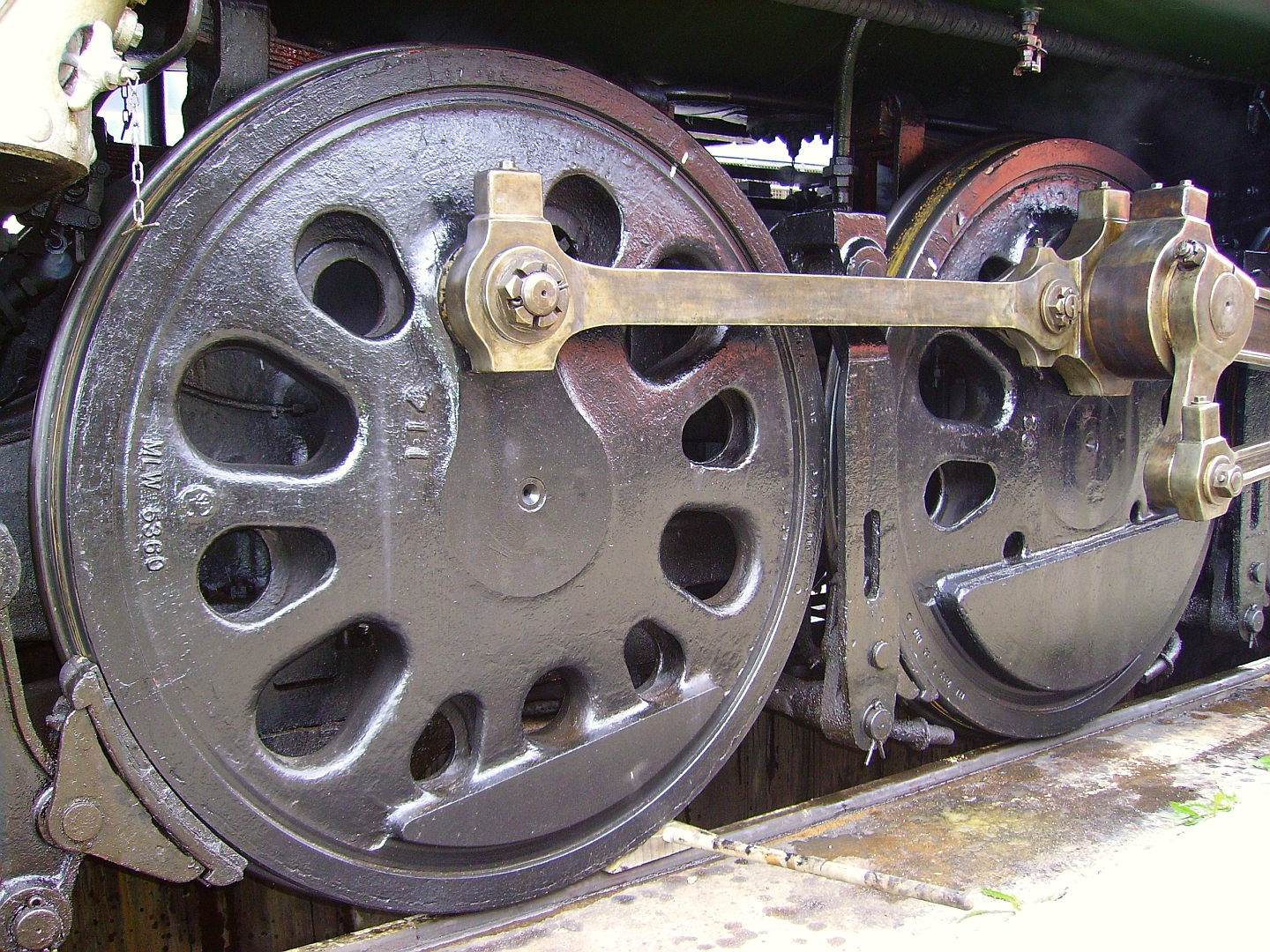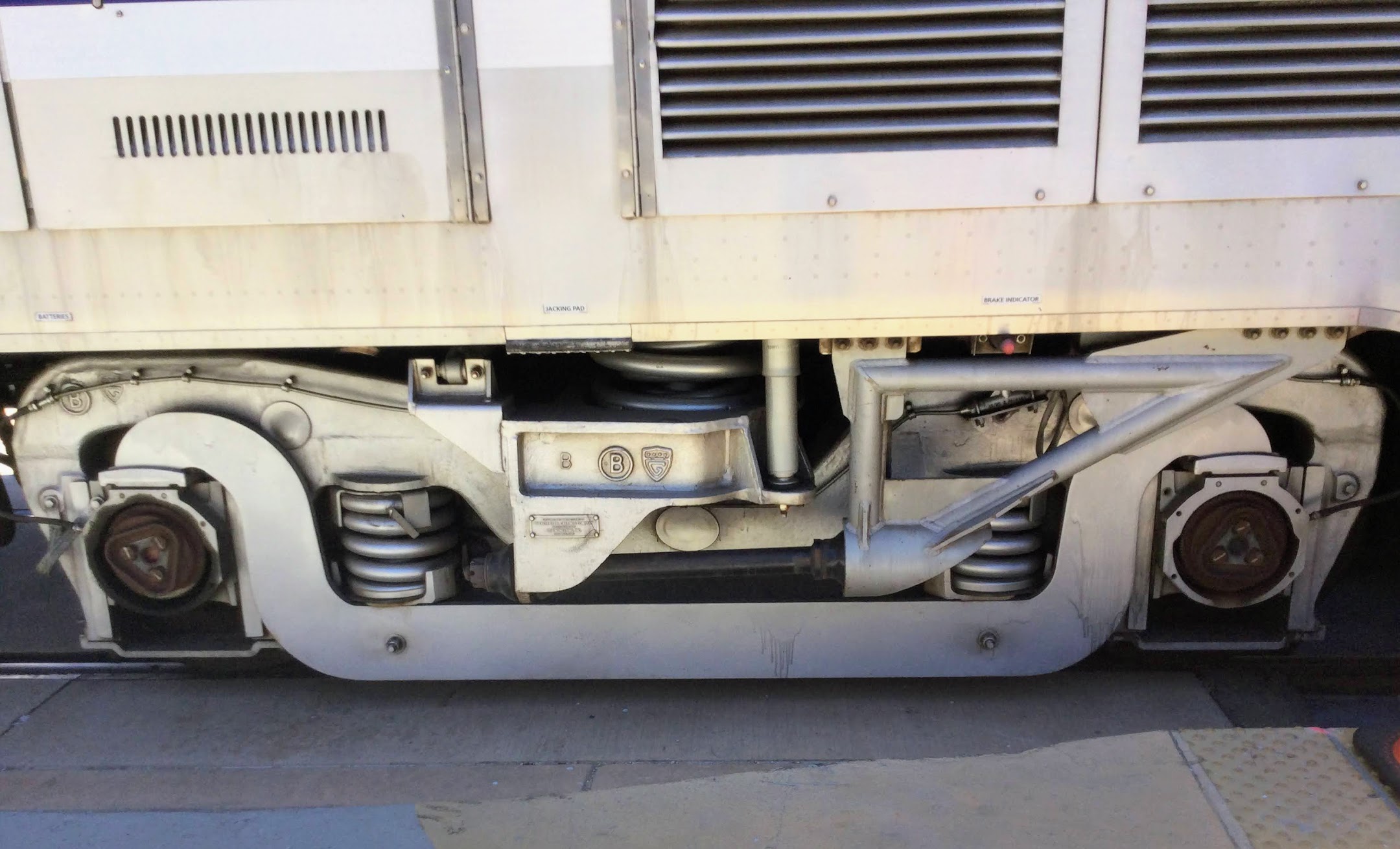|
Boxpok
A Boxpok is a steam locomotive wheel that gains its strength through being made of a number of box sections rather than having traditional solid spokes (the name is a variation on "box-spoke"). Being hollow, they allow better counterbalancing and stability than conventional drivers, which is important for fast locomotives. The Boxpok wheel was patented by General Steel Castings Corporation of Granite City, Illinois Illinois ( ) is a state in the Midwestern United States. Its largest metropolitan areas include the Chicago metropolitan area, and the Metro East section, of Greater St. Louis. Other smaller metropolitan areas include, Peoria and Rockf .... Other wheels The Boxpok was the most common of the four disk wheels in use by US steam locomotive designers, the others being the Baldwin and Scullin. A fourth design, the Universal, was used in locomotive rebuilds. All vary slightly in appearance but are essentially the same in structure. The term "Boxpok" is al ... [...More Info...] [...Related Items...] OR: [Wikipedia] [Google] [Baidu] |
SCOA-P Wheel
SCOA-P pattern wheels are a type of steam locomotive wheel. Rather than having traditional solid spokes, the SCOA-P spoke is hollow, with a 'U' shaped cross section. They are considerably lighter than a conventional spoked wheel or Boxpok wheel of the same size and strength. History SCOA-P wheels were developed in the late 1940s by the Steel Company of Australia Ltd (the P in the acronym standing for F. C. Paynter, who patented the design) in response to Victorian Railways experiencing fatigue problems with conventional spoked wheels. Stronger Boxpok type 'B' wheels had been installed on a number of VR locomotive classes in the late 1940s, but they had the disadvantage of being relatively heavy and also restricted maintenance access to axleboxes, underslung springs, and in some cases boiler washout plugs. Boxpok wheels were proposed for the forthcoming Victorian Railways R class 4-6-4, which had a relatively heavy axle load, but it had been discovered that the use of a Boxpok ... [...More Info...] [...Related Items...] OR: [Wikipedia] [Google] [Baidu] |
Bulleid Firth Brown Wheel
The Bulleid Firth Brown wheel (BFB) was a locomotive wheel developed for the Southern Railway in the late 1930s. It was a disc wheel, in contrast to the usual spoked wheels in general use on British railways. The wheel was designed by Oliver Bulleid and developed by the steel company Firth Brown of Sheffield. Design The BFB comprises a single disc, with teardrop-shaped indentations to give rigidity, and lightening holes to reduce weight. The advantage over a spoked wheel is that a disc wheel carries the tyre (the metal hoop shrunk onto the wheel to provide contact with the rail) more efficiently; spoked wheels are prone to shrink over time, causing the tyre to work loose, whilst in a disc wheel this is less pronounced. Disc wheels also distribute the weight more evenly, reducing the hammer effect on, and thus the damage to, the rail. The BFB weighed about ten per cent less than a spoked wheel of the same size.Day-Lewis p 146 Name The Bulleid Firth Brown, or BFB, is sometimes ... [...More Info...] [...Related Items...] OR: [Wikipedia] [Google] [Baidu] |
Steam Locomotive
A steam locomotive is a locomotive that provides the force to move itself and other vehicles by means of the expansion of steam. It is fuelled by burning combustible material (usually coal, oil or, rarely, wood) to heat water in the locomotive's boiler to the point where it becomes gaseous and its volume increases 1,700 times. Functionally, it is a steam engine on wheels. In most locomotives, the steam is admitted alternately to each end of its cylinders, in which pistons are mechanically connected to the locomotive's main wheels. Fuel and water supplies are usually carried with the locomotive, either on the locomotive itself or in a tender coupled to it. Variations in this general design include electrically-powered boilers, turbines in place of pistons, and using steam generated externally. Steam locomotives were first developed in the United Kingdom during the early 19th century and used for railway transport until the middle of the 20th century. Richard Trevithick ... [...More Info...] [...Related Items...] OR: [Wikipedia] [Google] [Baidu] |
Wheel
A wheel is a circular component that is intended to rotate on an axle Bearing (mechanical), bearing. The wheel is one of the key components of the wheel and axle which is one of the Simple machine, six simple machines. Wheels, in conjunction with axles, allow heavy objects to be moved easily facilitating movement or transportation while supporting a load, or performing labor in machines. Wheels are also used for other purposes, such as a ship's wheel, steering wheel, potter's wheel, and flywheel. Common examples are found in transport applications. A wheel reduces friction by facilitating motion by rolling together with the use of Axle, axles. In order for wheels to rotate, a Moment (physics), moment needs to be applied to the wheel about its axis, either by way of gravity or by the application of another external force or torque. Using the wheel, Sumer, Sumerians invented a device that spins clay as a potter shapes it into the desired object. Terminology The English word '':wi ... [...More Info...] [...Related Items...] OR: [Wikipedia] [Google] [Baidu] |
Spoke
A spoke is one of some number of rods radiating from the center of a wheel (the hub where the axle connects), connecting the hub with the round traction surface. The term originally referred to portions of a log that had been riven (split lengthwise) into four or six sections. The radial members of a wagon wheel were made by carving a spoke (from a log) into their finished shape. A spokeshave is a tool originally developed for this purpose. Eventually, the term spoke was more commonly applied to the finished product of the wheelwright's work, than to the materials they used. History The spoked wheel was invented to allow the construction of lighter and swifter vehicles. Earliest physical evidence for spoked wheels were found in Sintashta culture, dating to 2000 BC. Soon after this, horse cultures of the Caucasus region used horse-drawn spoked-wheel war chariots for the greater part of three centuries. They moved deep into the Greek peninsula where they joined with the exis ... [...More Info...] [...Related Items...] OR: [Wikipedia] [Google] [Baidu] |
Counterbalancing
A counterweight is a weight that, by applying an opposite force, provides balance and stability of a mechanical system. The purpose of a counterweight is to make lifting the load faster and more efficient, which saves energy and causes less wear and tear on the lifting machine. Counterweights are often used in traction lifts (elevators), cranes and fun fair rides. In these applications, the expected load multiplied by the distance that load will be spaced from the central support (called the "tipping point") must be equal to the counterweight's mass times its distance from the tipping point in order to prevent over-balancing either side. This distance times mass is called the load moment. A counterbalance is a weight or force that balances or offsets another as when two objects of equal weight, power, or influence are acting in opposition to each other. The objects are then said to be in counterbalance. Counterweights in action Trebuchet: There are five major components of ... [...More Info...] [...Related Items...] OR: [Wikipedia] [Google] [Baidu] |
General Steel Castings
General Steel Industries, Inc. (GSI) was an American steel company founded as General Steel Castings Corporation in 1928. The company's first headquarters were in Eddystone, Pennsylvania and, prior to completing its own modern steel foundry in 1930, acquired the operations of the Commonwealth Steel Company, a critical supplier to the rail industry.''The Commonwealther'', August 1929 (Commonwealth Steel Company, 1929), p. 3 An acquisition program to diversify from its core steel castings business of manufacturing large steel castings was initiated in the late 1950s and resulted in six divisions and one subsidiary by 1971.General Steel Industries, Inc., 1971 Annual Report, p. 4 The broader business portfolio allowed GSI to close the Castings Division, the company's only business prior to diversification, in 1973. In 1974, GSI was operating 19 plants across the United States and internationallyGeneral Steel Industries, Inc., 1974 Annual Report, p. 2 and continued operating as an ... [...More Info...] [...Related Items...] OR: [Wikipedia] [Google] [Baidu] |
Granite City, Illinois
Granite City is a city in Madison County, Illinois, United States, within the Greater St. Louis metropolitan area. The population was 27,549 at the 2020 census, making it the third-largest city in the Metro East and Southern Illinois regions, behind Belleville and O'Fallon. Officially founded in 1896, Granite City was named by the Niedringhaus brothers, William and Frederick, who established it as a steel making company town for the manufacture of kitchen utensils made to resemble granite. History Early settlement The area was settled much earlier than Granite City's official founding. In the early 19th century, settlers began to farm the rich fertile grounds to the east of St. Louis. Around 1801, the area saw the establishment of Six Mile Settlement, a farming area that occupied the area of present-day Granite City, six miles (10 km) from St. Louis. Soon after, around 1806, the National Road was to be constructed through the area, but it was never completed. By 1817, ... [...More Info...] [...Related Items...] OR: [Wikipedia] [Google] [Baidu] |
Illinois
Illinois ( ) is a U.S. state, state in the Midwestern United States, Midwestern United States. Its largest metropolitan areas include the Chicago metropolitan area, and the Metro East section, of Greater St. Louis. Other smaller metropolitan areas include, Peoria metropolitan area, Illinois, Peoria and Rockford metropolitan area, Illinois, Rockford, as well Springfield, Illinois, Springfield, its capital. Of the fifty U.S. states, Illinois has the List of U.S. states and territories by GDP, fifth-largest gross domestic product (GDP), the List of U.S. states and territories by population, sixth-largest population, and the List of U.S. states and territories by area, 25th-largest land area. Illinois has a highly diverse Economy of Illinois, economy, with the global city of Chicago in the northeast, major industrial and agricultural productivity, agricultural hubs in the north and center, and natural resources such as coal, timber, and petroleum in the south. Owing to its centr ... [...More Info...] [...Related Items...] OR: [Wikipedia] [Google] [Baidu] |
Train Wheels
In rail transport, a train (from Old French , from Latin , "to pull, to draw") is a series of connected vehicles that run along a railway track and transport people or freight. Trains are typically pulled or pushed by locomotives (often known simply as "engines"), though some are self-propelled, such as multiple units. Passengers and cargo are carried in railroad cars, also known as wagons. Trains are designed to a certain gauge, or distance between rails. Most trains operate on steel tracks with steel wheels, the low friction of which makes them more efficient than other forms of transport. Trains have their roots in wagonways, which used railway tracks and were powered by horses or pulled by cables. Following the invention of the steam locomotive in the United Kingdom in 1804, trains rapidly spread around the world, allowing freight and passengers to move over land faster and cheaper than ever possible before. Rapid transit and trams were first built in the late 1800s to ... [...More Info...] [...Related Items...] OR: [Wikipedia] [Google] [Baidu] |






.jpg)